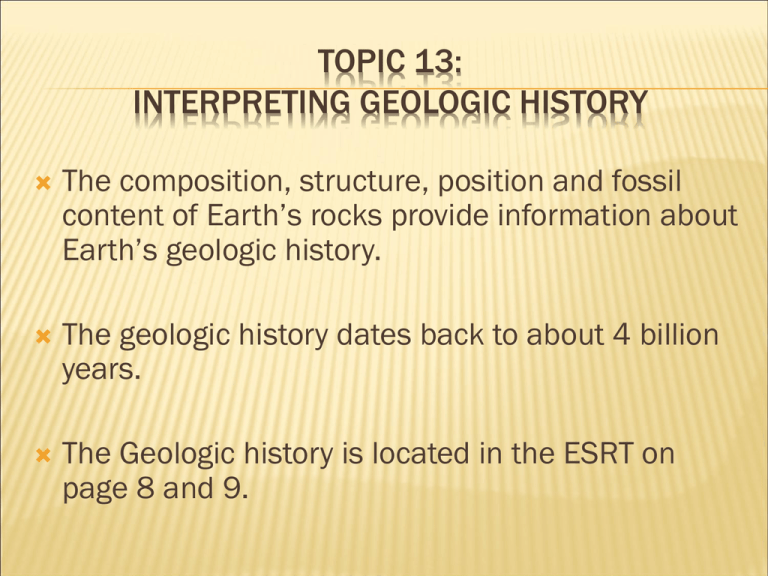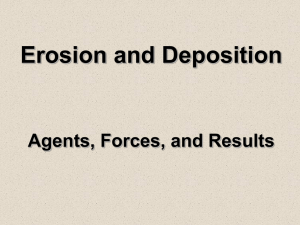Interpreting Geologic History: Relative Dating Methods
advertisement

TOPIC 13: INTERPRETING GEOLOGIC HISTORY The composition, structure, position and fossil content of Earth’s rocks provide information about Earth’s geologic history. The geologic history dates back to about 4 billion years. The Geologic history is located in the ESRT on page 8 and 9. RELATIVE DATING Relative Dating is the determination of the age of a rock or even in relation to the age of other rocks or events. Relative age differs from absolute age. Absolute age refers to the actual age of rock or an event in years. PRINCIPLE OF SUPERPOSITION When observing layers of sedimentary rocks, geologists assume the bottom layers is the oldest. Each layer is progressively younger, so the top layer is the youngest. This is called the LAW OF SUPERPOSITION. This rule is the used as a method for relative dating. An exception to this rule occurs, when the rocks layers have been overturned or flipped upside down. DATING INTRUSIONS, EXTRUSIONS AND INCLUSIONS When molten rock-magma squeezes into preexisting rocks hardens, it crystallizes to form an igneous rock body called an intrusion. An intrusion is younger, in relative age than any rock it cuts through. DATING INTRUSIONS, EXTRUSIONS AND INCLUSIONS When molten rock-lava flows on the surface and solidifies (hardens), it forms a mass of igneous rock called an extrusion. An extrusion is younger than any rocks beneath it, and older than rocks that may later form on top of it. DATING INTRUSIONS, EXTRUSIONS AND INCLUSIONS Often when magma rises toward the Earth’s surface, pieces of the rock the magma is intruding (pushing through) will fall into the magma. If the magma is cool enough, those pieces will not melt, they will become and inclusion. An inclusion is a body of older rock within igneous rock. DATING ROCK FEATURES Structural features in rocks can be used in relative dating For example, a rock is older than any fault, joint, tilting or fold that appears in it. The reason is that rocks form without these features, and are folded, tilted and cracked afterward. Rocks also contain mineral deposits called veins. A vein forms when a watery mineral solution fills a crack or a permeable zone in the rock. Like an intrusion, a vein is younger than the rock around it. In sedimentary rocks, the sediments are older than the sedimentary rock itself. In igneous rocks, the individual crystals vary in age because the form at different temperatures, reached by the magma as it cooled and hardened. RELATIVE DATING PRACTICE EXERCISES Below is a cross section for use practicing the application of the principles of relative age dating. For the cross section list the order of events that occurred to form the rocks illustrated. Make sure to include when erosion and deformation occurred. ** If there is a wavy line, erosion has occurred and if layers are not horizontal, folding has occurred** Answers: *Granite intrudes *Dike intrudes *Erosion *Deposition of Lower Sandstone *Deposition of Lower Shale *Deposition of Limestone *Tilting and *Erosion *Deposition of Upper Sandstone *Deposition of Shale *Erosion RELATIVE DATING PRACTICE EXERCISES Below is a cross section for use practicing the application of the principles of relative age dating. For the cross section list the order of events that occurred to form the rocks illustrated. Make sure to include when erosion and deformation occurred. ** If there is a wavy line, erosion has occurred and if layers are not horizontal, folding has occurred** Answers: *Gneiss forms *Erosion *Deposition of Sandstone (S.S.) *Dike intrudes *Erosion *Deposition of Shale (Sh.) *Dike II intrudes *Erosion *Deposition of Upper Sandstone *Faulting and Folding *Erosion *Volcanics Deposited *Erosion









